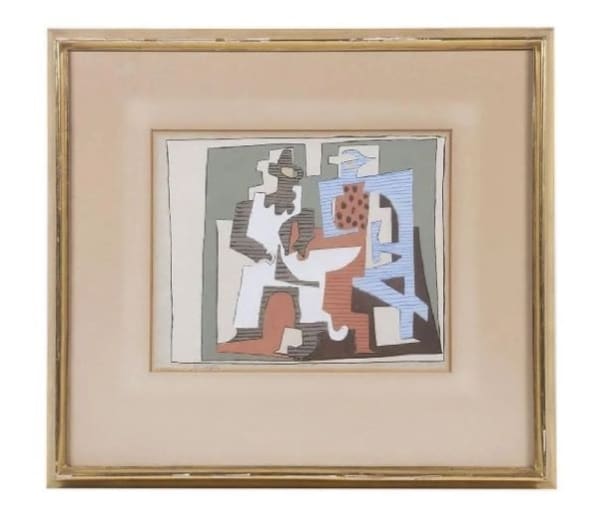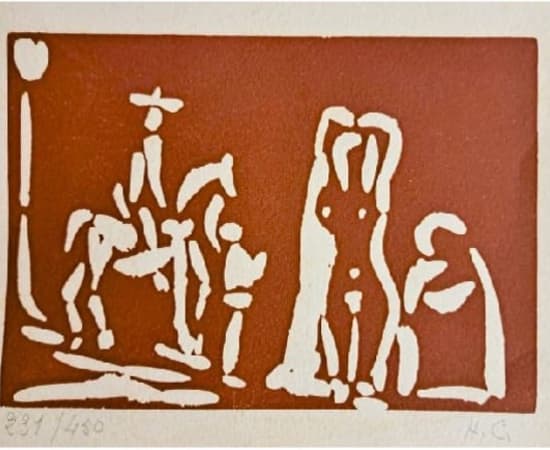Pablo Picasso Spanish, 1881-1973
-
 Pablo PicassoCavalier walking towards Celestine and Nude (New Years Card for 1968) , 1968Linocut17 3/8 x 20 1/8 in
Pablo PicassoCavalier walking towards Celestine and Nude (New Years Card for 1968) , 1968Linocut17 3/8 x 20 1/8 in
44 x 51 cmH.C. 402/440 -
 Pablo Picasso"ArlequinComposition after Pierrot et Arlequin", 1920Pochoir printed in colours, Juan-le-Pins, Summer 1920, signed by the artist in pencil.18 7/8 x 20 1/2 in
Pablo Picasso"ArlequinComposition after Pierrot et Arlequin", 1920Pochoir printed in colours, Juan-le-Pins, Summer 1920, signed by the artist in pencil.18 7/8 x 20 1/2 in
48 x 52 cmEdition of 100 -
 Pablo PicassoPeace ScarfSilk Scarf29 1/8 x 29 1/8 in
Pablo PicassoPeace ScarfSilk Scarf29 1/8 x 29 1/8 in
74 x 74 cm
Pablo Picasso was born on October 25, 1881, in Málaga, Spain. He was the son of Don José Ruiz y Blasco, a painter and art teacher, and María Picasso y López. Picasso’s talent for art became evident at a young age, and his father began formally training him in drawing and painting when he was just seven years old.
In 1895, the family moved to Barcelona, where Picasso enrolled in the Llotja School of Fine Arts. His prodigious talent quickly advanced him beyond the standard curriculum, and he began experimenting with a variety of styles and techniques. By 1897, he had moved to Madrid to attend the Royal Academy of San Fernando, but found the rigid formal education uninspiring. He instead immersed himself in the city’s vibrant art scene.
Artistic Periods and Innovations
Blue Period (1901-1904): Following the suicide of his close friend Carlos Casagemas, Picasso entered a phase of deep melancholy. His Blue Period paintings, characterized by somber tones and subjects, reflect this period of personal turmoil. Notable works from this period include “The Old Guitarist” and “La Vie.”
Rose Period (1904-1906): A marked shift from the Blue Period, the Rose Period features warmer hues and more cheerful themes, often depicting circus performers and acrobats. Important works from this time include “Family of Saltimbanques” and “Garçon à la Pipe.”
Cubism (1907-1914): Co-founding Cubism with Georges Braque, Picasso revolutionized art by deconstructing objects into geometric shapes and presenting multiple perspectives simultaneously. “Les Demoiselles d’Avignon” is a landmark work that exemplifies early Cubism. Picasso’s analytical and synthetic cubism phases produced significant works like “Girl with a Mandolin” and “Three Musicians.”
Classicism and Surrealism (1918-1936): Post-World War I, Picasso’s work returned to classical forms, but he also engaged with Surrealism. This period includes a blend of neoclassical figures and fantastical imagery, seen in works such as “Three Women at the Spring” and “Guernica,” the latter being a profound anti-war statement responding to the Spanish Civil War.
Later Work and Legacy
Picasso continued to innovate throughout his life, exploring various styles and media including sculpture, ceramics, and printmaking. His prolific output includes over 20,000 artworks. Picasso’s influence on 20th-century art is immeasurable, as he consistently pushed boundaries and inspired countless artists.
He passed away on April 8, 1973, in Mougins, France, leaving behind an enduring legacy as one of the most influential artists in history.
Why Picasso is Significant
Artistic Innovation:
• Cubism: Co-created with Georges Braque, Cubism broke away from traditional perspective, allowing the depiction of subjects from multiple viewpoints simultaneously. This was a radical departure from previous art forms and paved the way for many modern art movements.
• Diverse Mediums: Picasso was not limited to painting; he made significant contributions to sculpture, ceramics, printmaking, and stage design. His versatility and constant experimentation expanded the boundaries of what art could be.
Cultural Impact:
• Symbol of Modern Art: Picasso’s name is synonymous with modern art. His ability to adapt and reinvent his style kept him at the forefront of the art world for decades.
• Influence: His work influenced an array of art movements including Surrealism, Neoclassicism, and Abstract Expressionism. Artists across the globe have drawn inspiration from his innovative approaches.
Political Statements:
• “Guernica”: One of his most famous works, “Guernica,” is a powerful political statement against the brutality of war. It remains one of the most moving and potent anti-war paintings ever created.
Investment in Picasso’s Etchings
Historical and Artistic Value:
• Picasso’s etchings are not just artworks but historical documents that showcase his innovation and mastery over different techniques.
Rarity and Demand:
• Many of Picasso’s etchings were produced in limited editions, making them rare and highly sought after by collectors. Their scarcity can drive up their value over time.
Market Performance:
• Picasso’s works, including his etchings, have shown consistent appreciation in value. They often fetch high prices at auction, reflecting their investment potential.
Prestige:
• Owning a piece by Picasso carries significant prestige. As one of the most recognized and influential artists of the 20th century, his works are considered valuable assets.
Institutional Recognition:
• Picasso’s etchings are part of major museum collections worldwide, ensuring their ongoing visibility and recognition in the art world.





